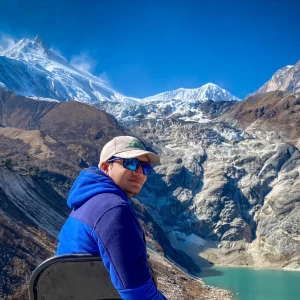- Manaslu Circuit Trek weather varies from 930m to 5,160m altitude, causing rapid changes.
- Temperatures range from -22°C in winter nights above 3,500m to 25°C in monsoon daytime below 2,000m.
- Nubri Valley lies in a rain shadow, receiving less rain than lower trail sections.
- Trail conditions include snow, ice, mud, and landslide risks depending on the season.
- The guide provides specific gear and safety tips tailored to each weather scenario.
Manaslu Circuit Trek Weather Guide: Prepare for Every Condition
Table of Contents
Weather is a key factor when planning the Manaslu Circuit Trek. The Manaslu Circuit Trek weather changes quickly with altitude and does not follow exact dates. In the best season, one day may be dry and the next very wet. That’s why knowing the real-time weather situation in the Manaslu region is more important than just following seasonal advice.
This guide provides clear details about the Manaslu Circuit Trek weather. It covers real trail conditions, temperatures, and what clothing and gear to use in each weather situation. It also explains how the weather affects your walking time and health at high altitudes.
By understanding how to prepare for changing weather, you can make better choices on the trail. You’ll know when to cross difficult parts safely, stay warm and dry, and avoid carrying extra gear.
Also check, Manaslu Circuit Trek Teahouse Guide
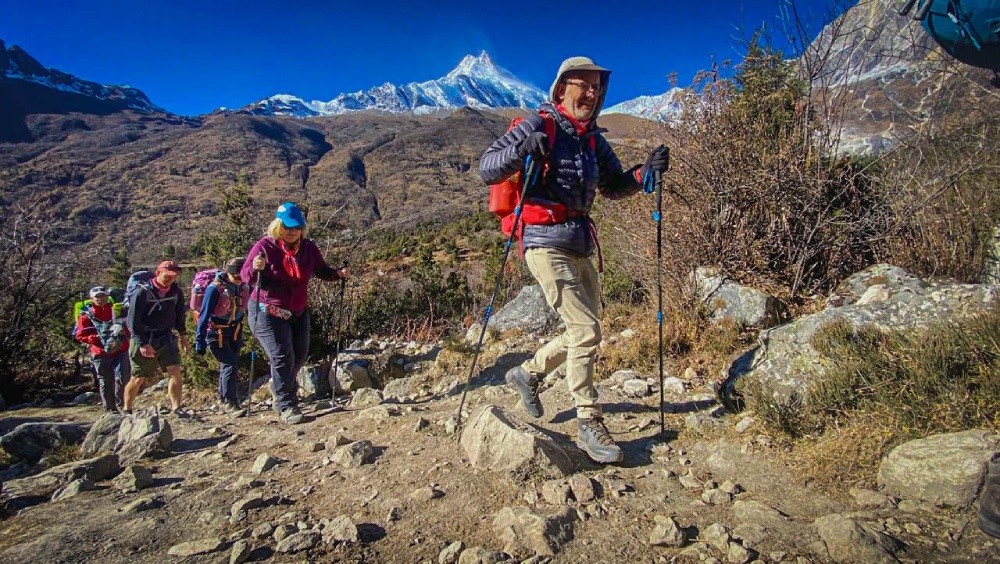
How to Read This Weather Guide
Most trekking guides tell you the best months to visit. But this guide is different. It shows how the weather behaves on the trail during those months. That means you’ll understand what actually happens each day, not just the season name.
We focus on what the weather feels like while trekking. This includes how fast the temperature drops with altitude, when rainfall starts, and where snow remains on the trail. Some parts may be dry while others are still slippery or frozen.
Each section explains one specific weather period. It includes daily temperature ranges, gear suggestions, and trail risks. It also gives safety tips for that weather case. These details help you decide what to carry and how to plan your trekking hours wisely.
Manaslu Circuit Trek Weather Overview
The Manaslu Circuit trekking trail moves through different climate zones in just a few days. Each zone experiences weather differently.
The trek starts around 930 meters in Machha Khola and rises to 5,160 meters at Larkya La Pass. Lower sections stay warmer and see more rainfall during monsoon. Higher areas remain colder with snow likely into late spring. Snow can still be found near Dharamshala even when lower areas are dry.
The Nubri Valley from Samagaun onwards lies in a rain shadow area. This section receives less rainfall even during monsoon months. However, winds around Larkya La Pass can be strong and sudden. Sudden storms and cloud build-up can happen, especially after midday. That’s why it is always advised to start early when crossing high points.
Month-by-Month Scenarios of Manaslu Circuit Trek Weather and Safety Guide
Weather changes month by month on the Manaslu Circuit. Each period brings different temperatures, trail risks, and gear needs. Below is a clear breakdown to help you prepare for each weather scenario along the trek.
Manaslu Circuit Trek Weather during Late Winter to Early Spring (February to March)
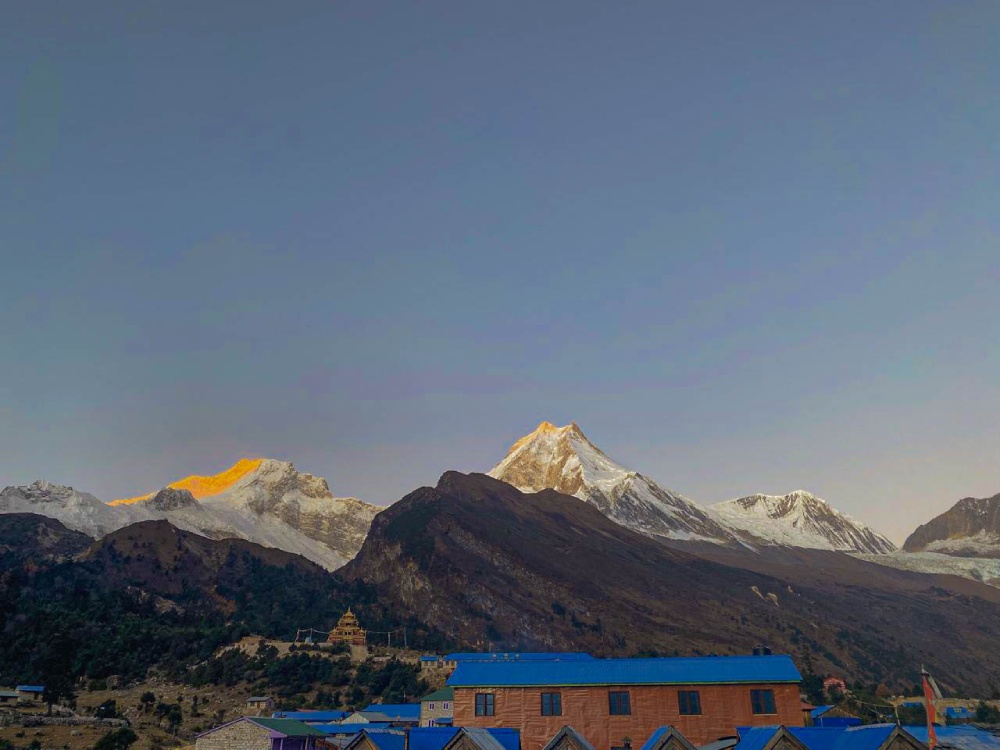
The weather begins to shift slowly in late winter. Lower areas like Machha Khola to Namrung stay between 2°C to 10°C during the day. Higher areas such as Samagaun and Dharamshala get much colder at night. Temperatures can drop to -18°C above 3,500 meters. Snow does not melt quickly due to low sunlight hours and cold ground. Early mornings remain the coldest on the trail, especially in shaded valleys and forested sections.
Weather Pattern
This period stays dry most days, but nights are cold and long. Snow remains packed above 3,000 meters. Even in the sun, melting is slow due to low ground warmth. Wind becomes stronger in the afternoon around Lho and Samdo. It picks up quickly and may affect your walking pace. Clouds stay thin, but frost often forms on the trail rocks overnight. Skies remain mostly clear with short daylight hours.
Trail Conditions
Below 2,500 meters, trails remain dry and rough but walkable. Once you cross Namrung, frozen patches begin to appear. From Lho onward, expect snow on the trail edges. Higher sections near Dharamshala stay snow-covered throughout the period. Icy rocks and frozen streams make morning walks harder. Some parts near Larkya La hold deep snow until mid-March. It is common to see frozen waterfalls alongside trails near Samdo.
Recommended Gear
Crampons or micro spikes are essential for grip on icy trails. Choose a strong waterproof trekking boot with ankle support. A proper down jacket rated for -20°C or lower is a must above Samagaun. Use a four-season sleeping bag with comfort rating below -20°C. Trekking poles with snow baskets help during steep, snowy climbs. Pack at least two pairs of gloves and gaiters to protect feet from snow entry.
Clothing Advice
Layering is the key to managing body heat. Use a thermal base layer, fleece mid-layer, and down outer layer. A waterproof shell is important for sudden wind exposure. Wear an insulated hat and woollen socks above 3,000 meters. Carry a neck buff to protect from windburn. Sunglasses with UV protection are necessary due to snow glare at high altitudes. Choose moisture-wicking clothes that dry quickly after sweating or snow exposure.
Safety Tips
Avoid starting too early in the morning as trails stay icy before 7-8 AM. Begin your walk once the sun warms the trail slightly. Larkya La is risky when snow or strong winds are forecast. Always ask your guide about next-day conditions. Spend one extra night in Samagaun to allow your body to adjust to high altitude. Stay hydrated and check your boots daily for signs of wetness or cold stress.
Manaslu Circuit Trek Weather during Spring Transition (April to Early June)
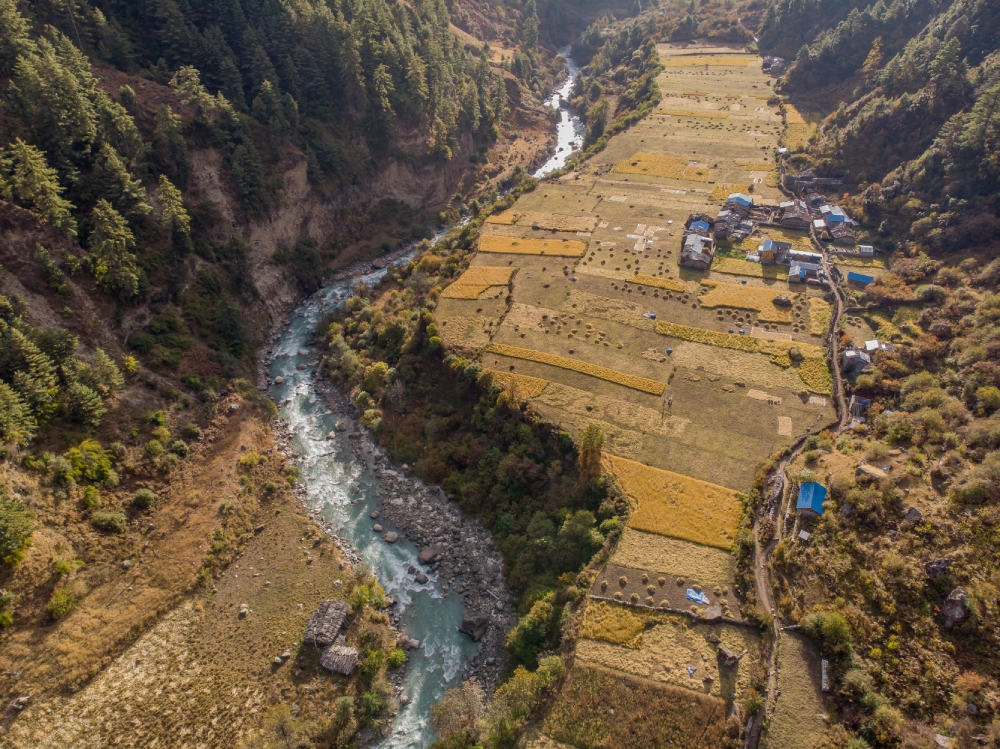
The weather begins to warm across the Manaslu Circuit Trek during spring. Lower areas like Jagat to Namrung see daytime temperatures between 10°C and 20°C. In higher sections above 3,000 meters, nighttime temperatures range from -5°C to 5°C. Day feels warmer when walking in direct sun, especially between 10 a.m. and 2 p.m. Nights remain cold in places like Samagaun and Dharamshala. The large temperature gap between day and night continues through April.
Weather Pattern
The skies are mostly clear with good sun visibility. Light rain may fall in the afternoon once or twice a week. Snow melts above 4,000 meters, especially near Bhimthang and Larkya La base areas. Warm air meets leftover snow, creating fog in high valleys. Midday becomes hot in lower sections, especially around Philim and Deng. Wind starts picking up after 2 p.m. in open areas, but storms are still rare in April.
Trail Conditions
The lower trail from Machha Khola to Ghap stays dry and dusty. Mules pass often, making the track loose. Above Namrung, you may notice water crossing the trail from melting snow. In places like Dharamshala and near Larkya La base, slush makes walking slippery. Snow may still be present in shaded areas, causing uneven footing. Higher slopes become unstable as the ice melts. That’s when landslides and rockfalls become more likely on open faces.
Recommended Gear
Trekking poles are useful for balance on wet, uneven trails above 3,500 meters. Gaiters help keep slush out of boots. Lightweight gloves protect hands from wind and sun. Sunscreen with SPF 50 or higher is necessary at altitude. UV sunglasses reduce glare from snow and bright skies. A brimmed cap or sun hat helps protect your face. A dry bag keeps gear safe from light rain or snowmelt soaking into your backpack.
Clothing Advice
Use a breathable base layer that dries quickly. Add a thin fleece for cooler mornings and shaded spots. A light-down jacket is helpful at night in villages above 3,000 meters. Carry a packable rain jacket to protect against surprise showers. Wear trekking trousers instead of shorts to avoid sunburn and trail dust. Avoid cotton layers as they stay wet for a long time. Always pack extra socks in case your shoes get soaked.
Safety Tips
Walk away from snow edges that may collapse as they melt. Sloped trails can turn muddy quickly, especially after 10 a.m. Wear shoes with solid grip and check laces often. Stay alert in narrow sections where thawing ice may loosen rocks. Avoid sitting near steep cliff walls. Drink more water than usual as the body loses fluids faster in warm air. Plan your walk to reach camp before the afternoon wind picks up.
Manaslu Circuit Trek Weather in Monsoon and Wet Conditions (Mid-June to Mid-September)
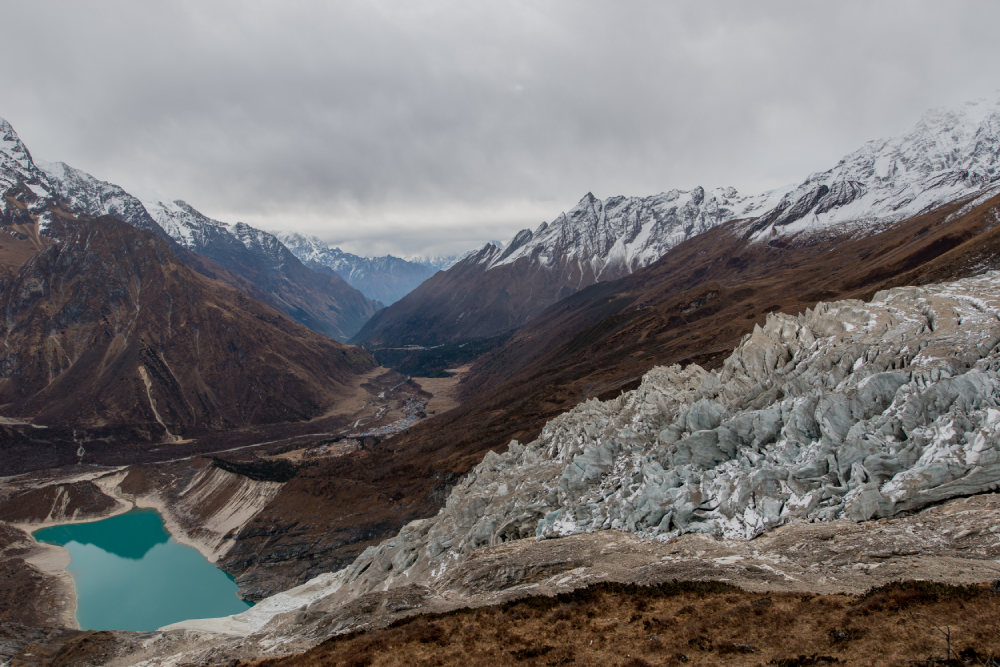
During monsoon, lower regions like Machha Khola and Jagat see daytime temperatures between 15°C and 25°C. Nights remain warm with 12°C or more below 2,000m. In higher villages like Samagaun, night temperatures drop to around 5°C. Cloud cover prevents strong sunlight, but the humidity stays high all day. Elevation helps cool the air after Namrung. The warmer air also speeds up fatigue, especially in wet clothes or with heavy packs.
Weather Pattern
The monsoon brings consistent rainfall almost every day. Rain falls mostly in the afternoon and evening. Skies stay overcast from morning to dusk. Low clouds settle in forested areas below 2,500m. Above Samagaun, rain lessens as the Nubri Valley lies in the rain shadow. Still, fog can build up even in dry spots. Rainwater often runs down the trail itself. It is common to walk through puddles or slippery ledges.
Trail Conditions
Below 2,000 meters, the trail becomes muddy and narrow due to frequent rainfall. Leeches appear mostly in grassy and forested areas after rainfall. From Khorlabesi to Philim, paths may wash out after heavy downpours. Higher sections like Lho and Samdo have fewer leeches but are still slippery. Stone steps turn slick, and loose soil washes away. Landslide-prone sections become active after two or more days of continuous rain.
Recommended Gear
Waterproof boots are a must to keep your feet dry and prevent blisters. Use a full rain suit or poncho with coverage past the knees. Carry at least one dry bag for your clothes and electronics. Leech repellent or saltwater helps if you’re bitten. Pack extra socks and keep them in a sealed plastic bag. Trekking poles improve balance on slick stones and muddy downhill slopes during rainy hours.
Clothing Advice
Use synthetic or wool clothing that dries fast after getting wet. Avoid cotton as it holds moisture and gets cold quickly. Wear a waterproof outer layer with a hood. Choose pants that dry easily and don’t cling when soaked. Pack a rain hat or cap with a wide brim. Use light gloves to keep your hands dry and clean. Always carry one full set of dry clothing in your backpack.
Safety Tips
First things first, we do not suggest trekking Manaslu during monsoon. However, always start your trek early before the rain begins in the afternoon. Watch the ground closely when walking through narrow, steep sections. Avoid crossing areas marked as landslide-prone without a guide. Don’t stop under overhanging rocks or cliffs when it’s raining. Do not attempt to cross flooded rivers or unstable bridges. If the rain gets heavy, wait in a safe shelter before continuing. Check that your boots are dry every morning.
Manaslu Circuit Trek Weather with Clear Skies and Cold Nights (Mid-September to November)
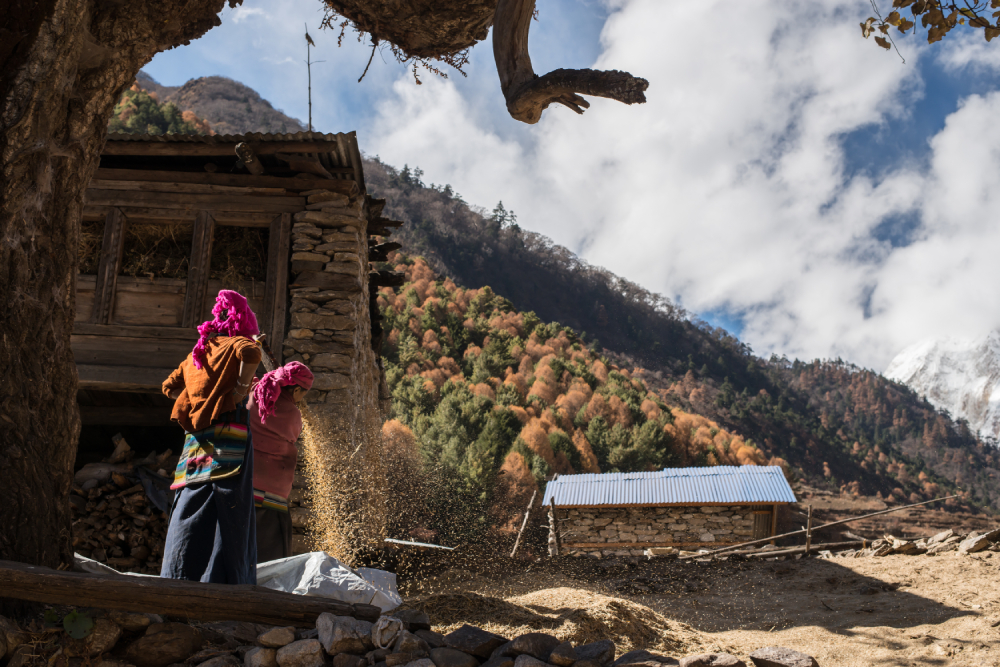
The Autumn period brings warm days and cold nights. Below 3,000 meters, daytime temperatures stay between 12°C and 18°C. Above 3,500 meters, nighttime temperatures often fall to -10°C. The air gets much colder after sunset. Frost forms early in the morning in villages like Samdo and Dharamshala. Sunlight feels strong, but shade areas remain cold. The temperature drops quickly after 4 p.m., especially in open areas above the tree line.
Weather Pattern
Skies remain clear with very little cloud cover most days. This results in strong daytime sun and cold dry nights. Humidity stays low, especially above 3,000 meters. Afternoon winds are common near Dharamshala and Larkya La base. Nights feel colder due to wind chill. No snowfall is expected unless there’s an early winter change in late November. The wind picks up sharply between 2 p.m. and 5 p.m. near exposed slopes.
Trail Conditions
The trail remains stable and dry throughout this season. Lower sections near Jagat and Philim become dusty by mid-October. Mule trains create loose stones and trail erosion. Higher up, the route from Lho to Samagaun stays packed and walkable. Some windy corners above Samdo may cause dust to blow in your eyes. Slopes remain firm during the day. No snow remains on the trail until late November, unless storms arrive early.
Recommended Gear
A down jacket rated for -20°C or lower is necessary above 3,000 meters. UV sunglasses protect your eyes from high-altitude sunlight. A windproof outer layer is useful during afternoon climbs. A thermal sleeping bag rated for -20°C comfort level is recommended. Carry trekking poles for extra balance on dry, dusty downhill sections. Lip balm and skin cream prevent dry skin. A good sun hat protects against strong sunlight before noon.
Clothing Advice
Dress in three layers: thermal base layer, fleece mid-layer, and windproof outer shell. Carry a neck buff to block dust. Gloves are helpful for early mornings and windy trails. Avoid thick jackets during the day in lower regions. Add warm socks and a beanie after 3,000 meters. Use a sun-protective shirt below 2,500 meters. Apply lip balm before bed to stop lips from cracking. Reapply moisturiser to the face twice a day.
Safety Tips
Carry a headlamp, as it gets dark by 5:30 p.m. in October. Always check your pace to avoid late arrivals. Sleep well at Samagaun before crossing Larkya La. Don’t rush through high points without enough acclimatization. Stay alert for signs of altitude sickness after Lho. Avoid sitting outside after sunset due to wind chill. Keep drinking water even when it feels cold. Add warm liquids like ginger tea to stay hydrated.
Manaslu Circuit Trek Weather in Harsh Winter (December to January)
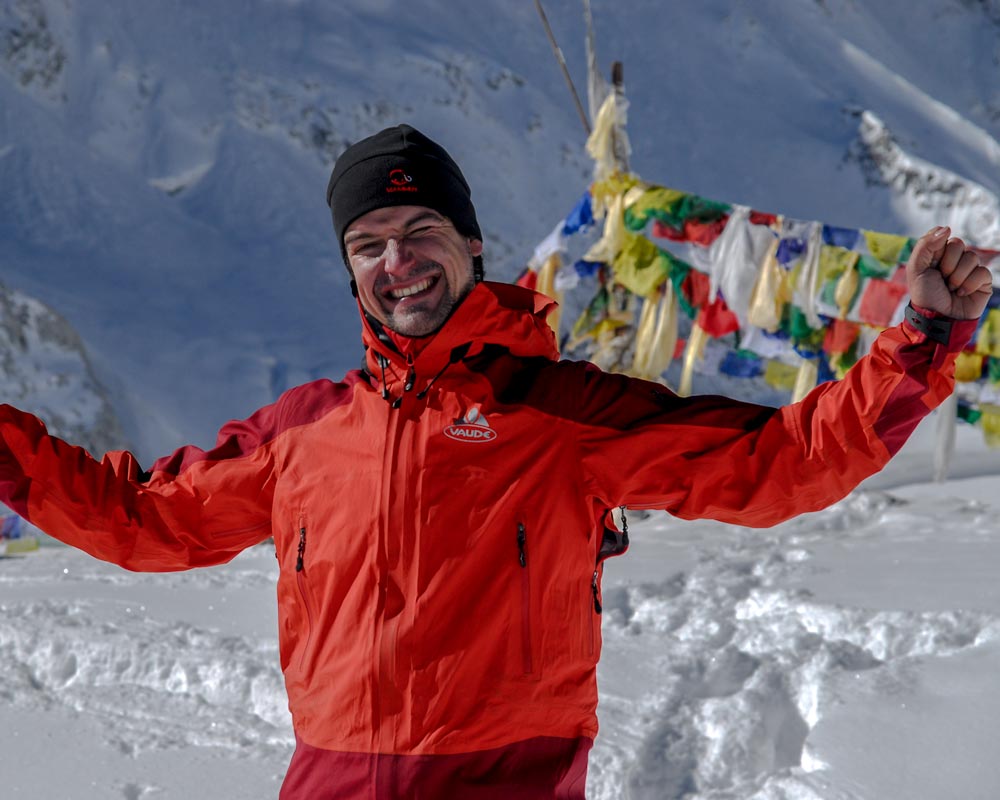
Winter on the Manaslu Circuit is extremely cold at higher elevations. Daytime temperatures stay between 0°C and 5°C around 2,000 meters. Above 3,500 meters, nights often drop between -10°C and -22°C. In places like Dharamshala, water freezes by late afternoon. The temperature change between sun and shade is wide. Once the sun sets, the cold air settles fast. Valley winds also increase the chill, especially after 4 p.m.
Weather Pattern
Clear skies are common, but sunlight provides little warmth. Wind makes even sunny days feel much colder. Snowfall may block upper sections, especially around Larkya La Pass. Snow remains longer due to low ground heat. Air is extremely dry, and skin cracks quickly without care. Wind chill below the pass often makes it feel colder than the actual temperature. Sudden snow flurries can occur without cloud buildup, mostly in the early mornings.
Trail Conditions
Most lower trails are icy in shaded forest areas. Near streams, frozen surfaces become slippery before noon. From Samagaun upward, snow remains packed and deep, especially near Dharamshala. The trail to Larkya La often holds knee-deep snow from late December onward. Fresh snow hides trail edges, increasing the risk of slips. Stone steps freeze overnight and stay icy until midday. Water taps may freeze in high elevations during the early morning.
Recommended Gear
Bring a fully insulated winter trekking setup. Use double-layered gloves for warmth and snow handling. Wear waterproof boots with insulation and ankle support. Carry extra batteries as cold drains power faster. A headlamp and power bank must be kept inside your sleeping bag. Emergency thermal blankets add backup heat if your bag fails. Trekking poles offer support on snow-covered ground. Gaiters help prevent snow entry around your ankles.
Clothing Advice
Use an expedition-grade down jacket for temperatures below -15°C. Wear two or more inner layers beneath your shell. Wool base socks help trap heat around your feet. Fleece neck warmers reduce exposure to wind. Use moisture-wicking thermals as your first layer to keep dry. A full fleece mid-layer adds insulation. Outer layers must be windproof and water-resistant. Always pack spare gloves, socks, and a second thermal hat for emergency use.
Safety Tips
Always ask local guides about the pass before planning your crossing. Larkya La may be blocked without notice. Watch fingers, toes, and nose for frostbite—tingling, numbness, or pale skin are early signs. Avoid trekking alone during this period, even in lower sections. Carry a satellite communication device if heading past Samdo. Take shorter trekking days and use warm lodges when available. Don’t ignore cold-related fatigue; rest when your body demands it.
Altitude-Based Temperature Reference Table for Manaslu Circuit Trek
Location | Elevation | Day Temp (°C) | Night Temp (°C) |
Machha Khola | 930m | 20–30 | 12–18 |
Namrung | 2,630m | 10–18 | 0–8 |
Samagaun | 3,530m | 5–15 | -5 to -10 |
Dharamshala | 4,460m | 0–10 | -8 to -15 |
Larkya La Pass | 5,160m | -5 to 5 | -10 to -20 |
Final Safety Tips for All-Weather Manaslu Trekking

Preparing for the Manaslu Circuit Trek means being ready for sudden weather changes and difficult trail conditions. Following these safety tips helps you stay secure, comfortable, and well-informed throughout your journey.
- Check daily weather and trail updates from your guide or villagers.
- Carry microspikes for icy sections, especially in winter and early spring.
- Use a waterproof rain cover and dry bags for your gear.
- Bring a headlamp for early starts, late finishes, and emergencies.
- Dress in layers to handle temperature and wind changes.
- Confirm conditions before crossing Larkya La Pass; postpone or cancel if unsafe.
- Stay hydrated and rest well to keep energy and reduce altitude sickness.
Conclusion
Manaslu Circuit trek weather shapes the adventure at every step. With the right information, gear, and planning, you can safely trek year-round. Always prepare based on actual weather conditions, not just the calendar.
Himalayan Scenery Treks is here to help you navigate the Manaslu Circuit trek weather and enjoy a safe, unforgettable journey.

